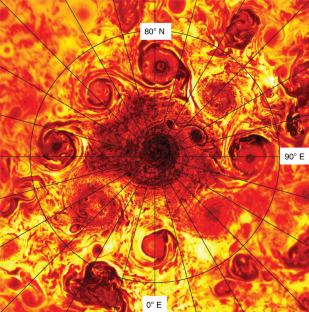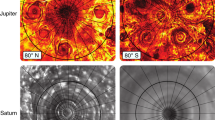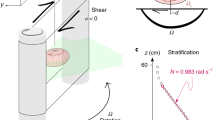Abstract
Since 2017 the Juno spacecraft has observed a cyclone at the north pole of Jupiter surrounded by eight smaller cyclones arranged in a polygonal pattern. It is not clear why this configuration is so stable or how it is maintained. Here we use a time series of images obtained by the JIRAM mapping spectrometer on Juno to track the winds and measure the vorticity and horizontal divergence within and around the polar cyclone and two of the circumpolar ones. We find an anticyclonic ring between the polar cyclone and the surrounding cyclones, supporting the theory that such shielding is needed for the stability of the polygonal pattern. However, even at the smallest spatial scale (180 km) we do not find the expected signature of convection—a spatial correlation between divergence and anticyclonic vorticity—in contrast with a previous study using additional assumptions about the dynamics, which shows the correlation at scales from 20 to 200 km. We suggest that a smaller size, relative to atmospheric thickness, of Jupiter’s convective storms compared with Earth’s, can reconcile the two studies.
This is a preview of subscription content, access via your institution
Access options
Access Nature and 54 other Nature Portfolio journals
Get Nature+, our best-value online-access subscription
$29.99 / 30 days
cancel any time
Subscribe to this journal
Receive 12 digital issues and online access to articles
$119.00 per year
only $9.92 per issue
Buy this article
- Purchase on Springer Link
- Instant access to full article PDF
Prices may be subject to local taxes which are calculated during checkout




Similar content being viewed by others
Data availability
JIRAM data are available online at the Planetary Data System (PDS) at https://pds-atmospheres.nmsu.edu/data_and_services/atmospheres_data/JUNO/jiram. The filenames of the images are listed in Supplementary Table 1. Calibrated, geometrically controlled radiance data mapped onto an orthographic projection centred on the north pole and velocity vectors derived from the radiance data are available in Supplementary Data 1–2.
References
Orton, G. S. et al. The first close-up images of Jupiter’s polar regions: results from the Juno mission JunoCam instrument. Geophys. Res. Lett. 44, 4599–4606 (2017).
Adriani, A. et al. Clusters of cyclones encircling Jupiter’s poles. Nature 555, 216–219 (2018).
Tabataba-Vakili, F. et al. Long-term tracking of circumpolar cyclones on Jupiter from polar observations with JunoCam. Icarus 335, 113405 (2020).
Adriani, A. et al. Two-year observations of the Jupiter polar regions by JIRAM on board Juno. J. Geophys. Res. https://doi.org/10.1029/2019JE006098 (2020).
Mura, A., Adriani, A. & Bracco, A. Oscillations and stability of the Jupiter polar cyclones. Geophys. Res. Lett. 48, e2021GL094235. https://doi.org/10.1029/2021GL0942235 (2021).
Grassi, D. et al. First estimate of wind fields in the Jupiter polar regions from JIRAM-Juno images. J. Geophys. Res. Planets 123, 1511–1524 (2018).
Orton, G. S. & Yanamandra-Fisher, P. A. Saturn’s temperature field from high-resolution middle-infrared imaging. Science 307, 696–698 (2005).
Dyudina, U. A. et al. Dynamics of Saturn’s south polar vortex. Science 319, 1801 (2008).
Dyudina, U. A. et al. Saturn’s south polar vortex compared to other large vortices in the Solar System. Icarus 202, 240–248 (2009).
Sommeria, J., Meyers, S. & Swinney, H. Laboratory model of a planetary eastward jet. Nature 337, 58–61 (1989).
Allison, M., Godfrey, D. & Beebe, R. A wave-dynamic interpretation of Saturn’s polar hexagon. Science 247, 1061–1063 (1990).
Aguiar, A. C. B., Read, P. L., Wordsworth, R. D., Salter, T. & Yamazaki, Y. H. A laboratory model of Saturn’s North Polar Hexagon. Icarus 206, 755–763 (2010).
Sanchez-Lavega, A. et al. The long- term steady motion of Saturn’s hexagon and the stability of its enclosed jet stream under seasonal changes. Geophys. Res. Lett. 41, 1425–1431 (2014).
Morales-Juberias, R., Sayanagi, K. M., Simon, A. A., Fletcher, L. N. & Cosentino, R. G. Meandering shallow atmospheric jet as a model of Saturn’s north-polar hexagon. Astrophys. J. Lett. 806, 1–6 (2015).
Scott, R. K. Polar accumulation of cyclonic vorticity. Geophys. Astrophys. Fluid Dynam. 105, 409–420 (2011).
O’Neill, M. E., Emanuel, K. A. & Flierl, G. R. Polar vortex formation in giant-planet atmospheres dues to moist convection. Nat. Geosci. 8, 523–526 (2015).
O’Neill, M. E., Emanuel, K. A. & Flierl, G. R. Weak jets and strong cyclones: shallow-water modeling of giant planet polar caps. J. Atmos. Sci. 73, 1841–1855 (2016).
Brueshaber, S. R., Sayanagi, K. M. & Dowling, T. E. Dynamical regimes of giant planet polar vortices. Icarus 323, 46–61 (2019).
Siegelman, L., Young, W. R. & Ingersoll, A. P. Polar vortex crystals: emergence and structure. Proc. Natl Acad. Sci. USA 119, e2120486119 (2022).
Siegelman, L. et al. Moist convection drives an upscale energy transfer at Jovian high latitudes. Nat. Phys. 18, 357–361 (2022).
Li, C., Ingersoll, A. P., Klipfel, A. P. & Brettle, H. Modeling the stability of polygonal patterns of vortices at the poles of Jupiter as revealed by the Juno spacecraft. Proc. Natl Acad. Sci. USA 117, 24082–24087 (2020).
Thomson, S. I. & McIntyre, M. E. Jupiter’s unearthly jets: a new turbulent model exhibiting statistical steadiness without large-scale dissipation. J. Atmos. Sci. 73, 1119–1141 (2016).
Rubio, A. M., Julien, K., Knobloch, E. & Weiss, J. B. Upscale energy transfer in three-dimensional rapidly rotating turbulent convection. Phys. Rev. Lett. 112, 144501 (2014).
Novi, L., von Hardenberg, J., Hughes, D. W., Provenzale, A. & Spiegel, E. A. Rapidly rotating Rayleigh-Benard convection with a tilted axis. Phys. Rev. E 99, 053116 (2019).
Yadav, R. K., Heimpel, M. & Bloxham, J. Deep convection-driven vortex formation on Jupiter and Saturn. Sci. Adv. 6, eabb9298 (2020).
Kapyla, P. J., Mantere, M. J. & Hackman, T. Starspots due to large-scale vortices in rotating turbulent convection. Astrophys. J. 742, 34 (2011).
Heimpel, M., Gastine, T. & Wicht, J. Simulation of deep-seated zonal jets and shallow vortices in gas giant atmospheres. Nat. Geosci. 9, 19–23 (2016).
Cai, T., Chan, K. L. & Mayr, H. G. Deep closely packed long-lived cyclones on Jupiter’s poles. Planet. Sci. J. 2, 81 (2021).
Ingersoll, A. & Cuzzi, J. Dynamics of Jupiter’s cloud bands. J. Atmos. Sci. 26, 981–985 (1969).
Limaye, S. Jupiter: new estimates of the mean zonal flow at the cloud level. Icarus 65, 335–352 (1986).
Li, L. M. et al. Life cycles of spots on Jupiter from Cassini images. Icarus 172, 9–23 (2004).
Garcia-Melendo, E., Perez-Hoyos, S., Sanchez-Lavega, A. & Hueso, R. Saturn’s zonal wind profile in 2004–2009 from Cassini ISS images and its long-term variability. Icarus 215, 62–74 (2011).
Dowling, T. A relationship between potential vorticity and zonal wind on Jupiter. J. Atmos. Sci. 50, 14–22 (1993).
Achterberg, R. & Ingersoll, A. A normal-mode approach to Jovian atmospheric dynamics. J. Atmos. Sci. 46, 2448–2462 (1989).
Wong, M. H., de Pater, I., Asay-Davis, X., Marcus, P. S. & Go, C. Y. Vertical structure of Jupiter’s Oval BA before and after it reddened: what changed? Icarus 215, 211–225 (2011).
Hammel, H. et al. HST Imaging of atmospheric phenomena created by the impact of Comet Shoemaker-Levy-9. Science 267, 1288–1296 (1995).
Rhines, P. Waves and turbulence on a beta-plane. J. Fluid Mech. 69, 417–443 (1975).
Theiss, J. Equatorward energy cascade, critical latitude, and the predominance of cyclonic vortices in geostrophic turbulence. J. Phys. Oceanogr. 34, 1663–1678 (2004).
Scott, R. K. & Polvani, L. M. Forced-dissipative shallow-water turbulence on the sphere and the atmospheric circulation of the giant planets. J. Atmos. Sci. 64, 3158–3176 (2007).
Mied, R. & Lindemann, G. Propagation and evolution of cyclonic Gulf-Stream rings. J. Phys. Oceanogr. 9, 1183–1206 (1979).
Chassignet, E. & Cushman-Roisin, B. On the influence of a lower layer on the propagation of nonlinear oceanic eddies. J. Phys. Oceanogr. 21, 939–957 (1991).
Adriani, A. et al. JIRAM, the Jovian Infrared Auroral Mapper. Space Sci. Rev. 213, 393–446 (2017).
Garcia-Ortega, E., Lopez, L. & Sanchez, J. L. Diagnosis and sensitivity study of two severe storm events in the Southeastern Andes. Atmos. Res. 93, 161–178 (2009).
Marion, G. R. & Trapp, R. J. The dynamical coupling of convective updrafts, downdrafts, and cold pools in simulated supercell thunderstorms. J. Geophys. Res. Atmos. 124, 664–683 (2019).
Solov’ev, A. A., Parfinenko, L. D., Efremov, V. I., Kirichek, E. A. & Korolkova, O. A. Structure of photosphere under high resolution: granules, faculae, micropores, intergranular lanes. Astrophys. Space Sci. 364, 222 (2019).
Juckes, M. Quasi-geostrophic dynamics of the tropopause. J. Atmos. Sci. 51, 2756–2768 (1994).
Held, I. M., Pierrehumbert, R. T., Garner, S. T. & Swanson, A. Surface quasi-geostrophic dynamics. J. Fluid Mech. 282, 1–20 (1995).
Lapeyre, G. & Klein, P. Dynamics of the upper oceanic layers in terms of surface quasigeostrophy theory. J. Phys. Oceanogr. 36, 165–176 (2006).
Lapeyre, G. Surface quasi-geostrophy. Fluids 2, 7–28 (2017).
Young, R. M. B. & Read, P. L. Forward and inverse kinetic energy cascades in Jupiter’s turbulent weather layer. Nat. Phys. 13, 1135–1140 (2017).
Gonzalez, R. C. & Woods, R. E. Digital Image Processing (Pearson, 2016).
Scarica, P. et al. Stability of the Juoter southern polar vortices inspected through vorticity using Juno/JIRAM data. J. Geophys. Res., Planets, https://doi.org/10.1029/2021JE007159 (2021).
Acknowledgements
This research was carried out at the California Institute of Technology under a contract with the National Aeronautics and Space Administration (NASA), grant/cooperative agreement number 80NSSC20K0555, which was awarded to A.P.I., and a contract with the Juno mission, which is administered for NASA by the Southwest Research Institute. C.L. was supported by the 51 peg-b Postdoctoral Fellowship. JIRAM was supported by the Italian Space Agency through ASI‐INAF agreement numbers I/010/10/0, 2014‐050‐R.0, 2016-23-H.0 and 2016-1495 f23-H.1-2018. A.A., A.M., D.G. and F.T. were supported by INAF. C.P. and G.S. were supported by ASI. L.S. is funded by the Scripps Institution of Oceanography Postdoctoral Fellowship. P.K. acknowledges funding from JPL/NASA.
Author information
Authors and Affiliations
Contributions
A.P.I. led the research and wrote the document. S.P.E. conducted the data analysis and prepared the figures. F.T. prepared the geometric tables that were used in the analysis. A.A., A.M., D.G., C.P. and G.S. oversaw the successful functioning of the JIRAM instrument and provided expertise on using it for image processing. C.L., L.S., P.K. and W.R.Y. provided expertise on vortices.
Corresponding author
Ethics declarations
Competing interests
The authors declare no competing interests.
Peer review
Peer review information
Nature Astronomy thanks Jonathan Aurnou and Stephen Thomson for their contribution to the peer review of this work.
Additional information
Publisher’s note Springer Nature remains neutral with regard to jurisdictional claims in published maps and institutional affiliations.
Supplementary information
Supplementary Information
Supplementary Figs. 1–7, Tables 1 and 2 and Sections 1–7.
Supplementary Data 1
Infrared brightness mapped onto a tangent plane at the pole.
Supplementary Data 2
Velocity vectors derived from pairs of brightness images.
Supplementary Data 3
Measured azimuthal velocity for Fig. 4.
Rights and permissions
Springer Nature or its licensor holds exclusive rights to this article under a publishing agreement with the author(s) or other rightsholder(s); author self-archiving of the accepted manuscript version of this article is solely governed by the terms of such publishing agreement and applicable law.
About this article
Cite this article
Ingersoll, A.P., Ewald, S.P., Tosi, F. et al. Vorticity and divergence at scales down to 200 km within and around the polar cyclones of Jupiter. Nat Astron 6, 1280–1286 (2022). https://doi.org/10.1038/s41550-022-01774-0
Received:
Accepted:
Published:
Issue Date:
DOI: https://doi.org/10.1038/s41550-022-01774-0



